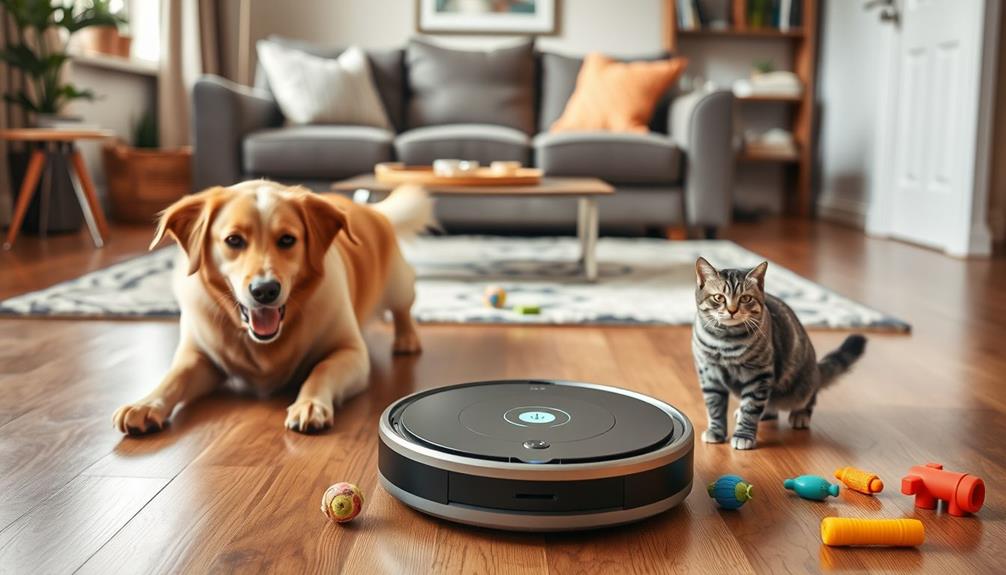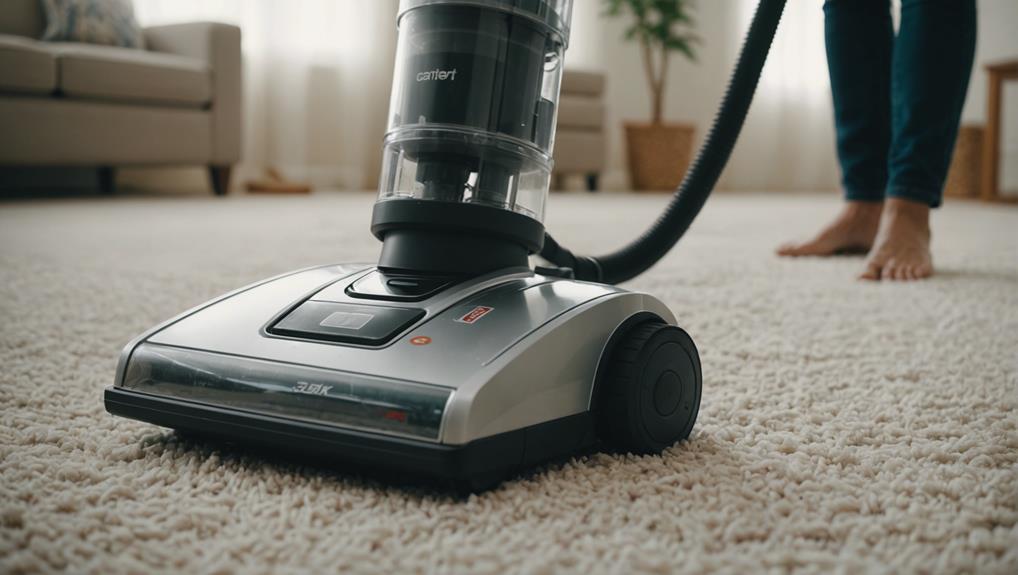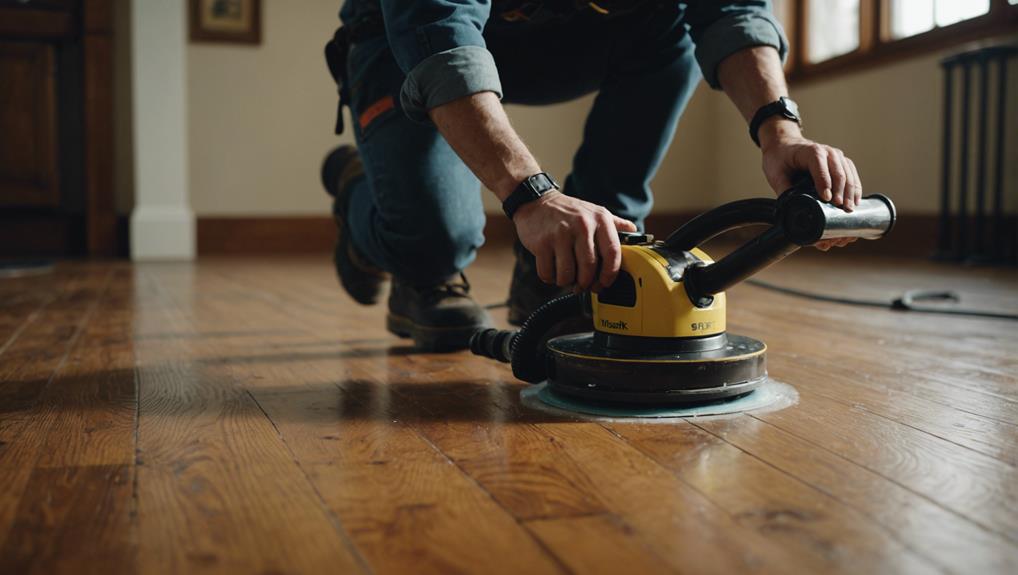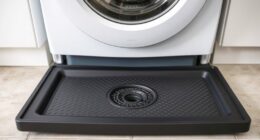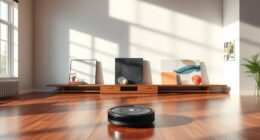To ensure your furry companions stay safe around **robot vacuums**, opt for a model specifically made to tackle **pet hair** with solid suction and navigation capabilities. Ease your pets into the vacuum by introducing it gradually and using positive reinforcement. Prep your living space by removing any potential hazards, securing cables, and relocating food and water bowls. Regularly maintain the vacuum to prevent any unwanted odors and signs of wear. **Keep an eye on your pets** while the vacuum is running and observe their reactions to help alleviate any anxiety. By following these tips, you can guarantee a smoother cleaning process for both you and your beloved pets, and there’s more helpful information coming up. Why wait? Let’s dive in and make sure your pets are well taken care of!
Key Takeaways
- Choose robot vacuums designed for pet hair, featuring strong suction power and self-cleaning brushes for easier maintenance.
- Gradually introduce the vacuum to pets, using positive reinforcement to alleviate fear and anxiety during initial exposure.
- Ensure a safe cleaning environment by removing small toys, securing cables, and relocating pet food and water bowls.
- Regularly clean and inspect the vacuum for damage to maintain optimal performance and prevent unpleasant odors.
- Monitor pets during cleaning cycles and establish routines to help them adjust to the vacuum's presence.
Choosing the Right Robot Vacuum
When you're on the hunt for the perfect robot vacuum, it's vital to focus on models designed specifically for pet hair. These robot vacuum cleaners often feature enhanced suction power and specialized brushes that efficiently handle pet hair, ensuring your home stays clean and fur-free.
For instance, options like the Bissell Pet Hair Eraser offer self-cleaning brush roll technology, making maintenance easier for pet owners. Look for smart vacuums with advanced navigation capabilities like smart mapping and obstacle detection, so they can safely maneuver around your pets and household items without causing disturbances.
Noise levels are also significant; quieter models operating within the 65-80 decibel range are less likely to startle your furry friends, creating a more comfortable cleaning environment.
Additionally, assess the compatibility of the vacuum with your home's flooring types. Some models excel on mixed surfaces, ensuring a thorough clean without damaging delicate flooring.
Training Pets for Robot Vacuum Use

Introducing a robot vacuum to your pets can be a smooth process with the right approach. Start by letting them explore the vacuum while it's off. This helps minimize fear and allows them to get used to its presence without anxiety.
Engaging in outdoor play can also help reduce stress levels in your pets, making them more adaptable to new experiences. Once they seem comfortable, gradually turn on the vacuum for short periods. Increase the duration as your pets become more accustomed to the sound and movement.
During this time, focus on training your pets using positive reinforcement. Reward them with treats when they display calm behavior around the robot vacuum while it's operating. This will create a positive association with the machine and encourage them to stay relaxed.
Keep a close eye on your pets during the initial cleaning cycles. Look for any signs of anxiety or aggression, and make adjustments as needed to their environment or the vacuum's operation.
Implement gradual desensitization techniques by incorporating the robot vacuum into your regular routines. Over time, your pets will adapt to its presence, making cleaning easier for everyone.
With patience and consistency, your pets will learn to coexist happily with the robot vacuum.
Preparing the Cleaning Area

A tidy cleaning area is vital for your robot vacuum to operate effectively. As a pet owner, you'll want to guarantee that any small toys or potential hazards are cleared from the floor. This prevents clogs and helps the vacuum navigate smoothly.
Additionally, consider using a vacuum model designed for pet hair, as they often have features that enhance performance in pet-friendly homes, such as top-rated vacuums for pet fur. Move pet food and water bowls out of the cleaning path to avoid spills and interruptions during operation.
Next, secure any cables and cords that could cause tangling or damage. Loose items can obstruct the vacuum's path, so take a moment to check for obstacles that might hinder its performance.
It's vital to create a space that allows your robot vacuum to clean efficiently.
Maintaining the Robot Vacuum

Maintaining your robot vacuum is key to keeping it running smoothly and effectively, especially in a pet-friendly home. Regularly cleaning the brushes and filters is essential for peak suction power. Pet hair and debris can quickly build up, leading to clogs that considerably reduce your vacuum's cleaning efficiency.
To guarantee you select the right vacuum for your needs, consider what to look for in a home cleaning service. Aim to empty the dustbin after every use to prevent overflowing, which can create odors and further decrease suction.
Inspect your vacuum for signs of damage or wear at least once a month. This proactive approach helps you identify potential issues before they affect performance. Make sure you follow the manufacturer's maintenance instructions closely, as each model may have specific upkeep requirements.
Don't forget to replace worn or damaged parts promptly. Filters and brushes, in particular, need timely replacement to maintain the vacuum's efficiency, especially in homes with pets that shed frequently.
Supervising Robot Vacuum Operations

During your robot vacuum's cleaning cycle, it's crucial to supervise its operations, especially in homes with pets. Closely monitor your pet's behavior while the vacuum is running. Look for signs of anxiety, fear, or aggression, so you can intervene if necessary. If your pet seems distressed, consider using the vacuum when they're in another room to maintain a calm environment.
Additionally, creating a routine can help both you and your pets adjust better to the vacuum's presence, much like how familiar sounds in a kitchen can enhance cooking experiences, such as the health benefits of juicing.
While supervising, keep an eye on the vacuum's navigation. Confirm it doesn't get stuck on pet toys or other obstacles that could lead to damage or operational issues.
Also, double-check that your pets are safe from potential hazards, like cords or loose items, during the vacuum's cleaning cycle to avoid accidents or injuries.
Establishing a consistent routine for using the robot vacuum can help your pets adjust to its sound and movement over time. This familiarity promotes a more relaxed coexistence and enhances pet safety.
Advanced Features for Pet Owners

When you're choosing a robot vacuum for your home, look for advanced features that cater specifically to pet owners. Robot vacuum cleaners equipped with powerful suction, like the DEEBOT T30 PRO OMNI, can provide up to 11,000Pa of suction to effectively remove pet hair and dander from various surfaces. This means a cleaner space for both you and your furry friends.
Additionally, using an air purifier alongside your vacuum can further enhance your home's air quality, especially when dealing with pet allergens and odors importance of air purifiers.
Smart navigation technologies, such as LiDAR mapping, help these vacuums maneuver safely around pets and obstacles, guaranteeing thorough cleaning without causing distress.
Additionally, many models offer quiet operation modes, typically running between 65-80 decibels, which is perfect for maintaining a calm environment for sensitive pets during cleaning sessions.
Look for models that combine vacuuming and mopping capabilities, as this dual functionality makes it easier to tackle pet-related messes and stains all in one go.
Advanced sensors are also vital; they enhance obstacle detection and navigation, allowing the vacuum to recognize and avoid pet waste and other hazards.
Common Dog Reactions to Vacuums

When you introduce a robot vacuum into your home, your dog might respond in various ways. Some may approach it with curiosity, while others might bark and hide in fear.
Energetic pups might even see it as a playful target to chase around the house. It's important to take into account that just like cats, dogs can exhibit stress or anxiety related to unfamiliar noises and movements, which can affect their overall behavior and well-being.
Reinforcing calm behavior during vacuuming with treats or praise can help alleviate any potential anxiety, similar to how cats show attachment to their owners.
Curiosity and Exploration
Curiosity often gets the best of our four-legged friends when a robot vacuum rolls into their space. Many pets approach the robotic vacuum with wagging tails, keen to sniff and investigate this new, moving object. Your dog might see it as a potential playmate, especially if they're energetic and playful, possibly even chasing or pouncing on it like a toy. This playful exploration highlights their natural curiosity, making the vacuum an engaging distraction.
Additionally, understanding your dog's astrological traits may provide insights into their behavior, as certain signs may influence curiosity levels and personality traits, making your pet's reaction more predictable in some cases astrology claims to influence personal traits.
However, not all dogs react the same way. Some might show indifference, completely ignoring the robotic vacuum as it works around them, which can indicate that they've adapted to its presence. If your dog has had previous exposure to vacuums, they may not find it as intriguing.
But remember, individual reactions can vary considerably based on factors like breed characteristics and past experiences. While one pet may be inquisitive, another could be more cautious or indifferent. Understanding your dog's unique response to the robotic vacuum can help you create a safer and more comfortable environment for them.
Fear and Anxiety
While some dogs may approach robot vacuums with excitement, others can respond with fear and anxiety. Around 35% of dogs show signs of distress when exposed to loud, unfamiliar noises, like those produced by robotic vacuums. If your pet exhibits fear reactions—such as barking, hiding, or showing signs of stress—it's vital to manage this properly during the introduction phase. Incorporating stress management techniques can greatly enhance your pet's comfort level around the vacuum.
Individual personalities and breed characteristics play a role in how dogs react; while some may be curious, others might feel overwhelmed. To help your furry friend adjust, use gradual introduction techniques. Start with the vacuum turned off, rewarding calm behavior with treats to reduce their fear response.
It's important to monitor your dog's body language while the vacuum operates. Signs of anxiety, like cowering or excessive barking, indicate that further desensitization and training are necessary.
Playful Interactions
Robot vacuums often spark playful interactions in dogs, turning an ordinary cleaning session into an exciting game. Your pet may chase or pounce on the vacuum, driven by curiosity and instinct. This playful behavior is influenced by their personality, breed, and previous exposure to similar devices.
| Dog Reaction | Description |
|---|---|
| Chasing | Dogs may dart after the moving robot, viewing it as a toy. |
| Barking and Tail Wagging | Enthusiastic responses show they're engaged and excited. |
| Pouncing | Some dogs might leap at the vacuum, wanting to "play" with it. |
As you observe your dog's reactions, you can gauge their comfort with this new technology. If your pet seems too excited, it's beneficial to help them get used to the robot vacuum. Use positive reinforcement, like treats and praise, to encourage calm behavior and reduce overly exuberant interactions. This approach fosters a harmonious environment, allowing both you and your furry friend to cohabitate peacefully with your cleaning companion.
Frequently Asked Questions
Are Robot Vacuums Safe With Pets?
Are robot vacuums safe with pets? Yes, they can be!
Many models come equipped with advanced navigation systems that detect obstacles, including your furry friends. They operate quietly, which helps reduce any anxiety your pets might feel during cleaning.
Can Robot Vacuums Avoid Pet Waste?
Did you know that nearly 70% of pet owners worry about their robot vacuum running into pet waste?
Luckily, many advanced models, like the iRobot Roomba j7+, feature technology specifically designed to avoid such messes.
With PrecisionVision Navigation, these vacuums identify and steer clear of pet waste, keeping your home clean and mess-free.
What Are the Safety Precautions for Roomba?
To guarantee safety with your Roomba, start by equipping it with obstacle detection sensors.
Keep small objects, like pet toys and cables, out of its cleaning path to avoid entanglement.
Monitor your pet's behavior during the first few runs, adjusting the schedule if needed.
Use the virtual wall feature to create boundaries, and regularly check the Roomba for wear and tear to make certain all safety features are functioning properly.
What to Do if Your Robot Vacuum Runs Over Dog Poop?
If your robot vacuum rolls over dog poop, it's a disaster waiting to happen.
First, stop the vacuum immediately to prevent a bigger mess.
Wearing gloves, carefully remove the solid waste from the brushes and wheels.
Clean all affected parts with disinfectant wipes to banish odors and bacteria.
Finally, check the filters; you might need to replace them if they've absorbed any mess.
Stay calm, and tackle it step by step!
Conclusion
In the end, you might think that having a robot vacuum means less work and more peace, but let's be real: it's just another thing for your pets to be suspicious of. With a little training and supervision, though, you can turn that fear into curiosity. After all, who wouldn't want to watch their dog battle a tiny, whirring machine? Embrace the chaos, and enjoy the unexpected entertainment while keeping your home clean!
